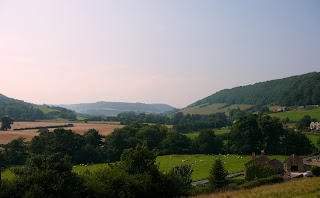Probably the hottest day of the year so far saw me heading for the nearest chunk of the North York Moors National Park – Forge Valley.
I parked at West Ayton, a village about three miles west of Scarborough. I saved the path by Ayton Castle for the return leg, to use the higher way along the top of the western side of the valley. The path runs pleasantly above the steep valley, dipping into the edge of the wood.
Rather than constantly referring to the map I used my preferred method of scanning the route at the start of the walk and keeping the map in the rucksack for occasional reference at points of doubt. The problem with this approach is that it is easy to be beguiled by clear well-used paths which wander off the intended right of way. And so I was…
Forge Valley is a National Nature Reserve and furnished with tracks off the established rights of way. I happily wandered along one such track before realising my mistake. Not to worry, there were other, wilder and narrower ways, one furnished, initially, with duck boarding, heading in my intended direction.
The next half mile took the best part of an hour. I traversed the steep, in places precipitous, side of the valley, constantly deviating around fallen trees and branches, patches of deep mire and loose, muddy and unstable ground. It was an entertaining interlude in the hot, humid air, beset by voracious insects intent on feasting on my now bloody arms. It was a training walk after all.
I eventually rejoined the main track and continued on a more sedate course towards Hackness, passing the idyllic hamlet of Wrench Green. The Derwent valley, from the river’s source by the Fylingdales Early Warning station, to Forge Valley, is probably my favourite Moor’s dale and certainly one of the area’s most scenic.
After flirting with the river for a short while I took the path high behind Hackness Mere and Hall. I sat for a while with my boots off, socks steaming, munching a banana and apple, making a fine contrast to the pampered souls lounging in the gardens of the house below.
After dropping down to the valley bottom at Hackness, the path annoyingly climbs through a narrow, tree-lined gully, to regain the considerable lost height. Near the top a large tree had recently dropped, blocking further progress along the path: another inelegant jostle, up, over and round the obstacle ensued before gaining the hill top.
The path down to Mowthorpe Farm is a delight, dropping down through more woods and pasture to the road. There is no real alternative but to use the lane back to Forge Valley, but it is quiet and in magnificent surroundings. It is hard to believe that Scarborough, no doubt heaving on a hot summer Sunday, is only two or three miles to the east.
After a mile or so the lane is abandoned and the river is crossed by a footbridge to take an easy duck-boarded path downstream, through the woods, passing Ayton Castle, back to the village and car.
The walk was about ten miles long. It was much more demanding than I’d intended because of the heat and the adventure in the woods, but highly enjoyable nonetheless. Apart from the valley bottom path at Forge Valley, where there were strollers aplenty, I didn’t see another walker all day.



























